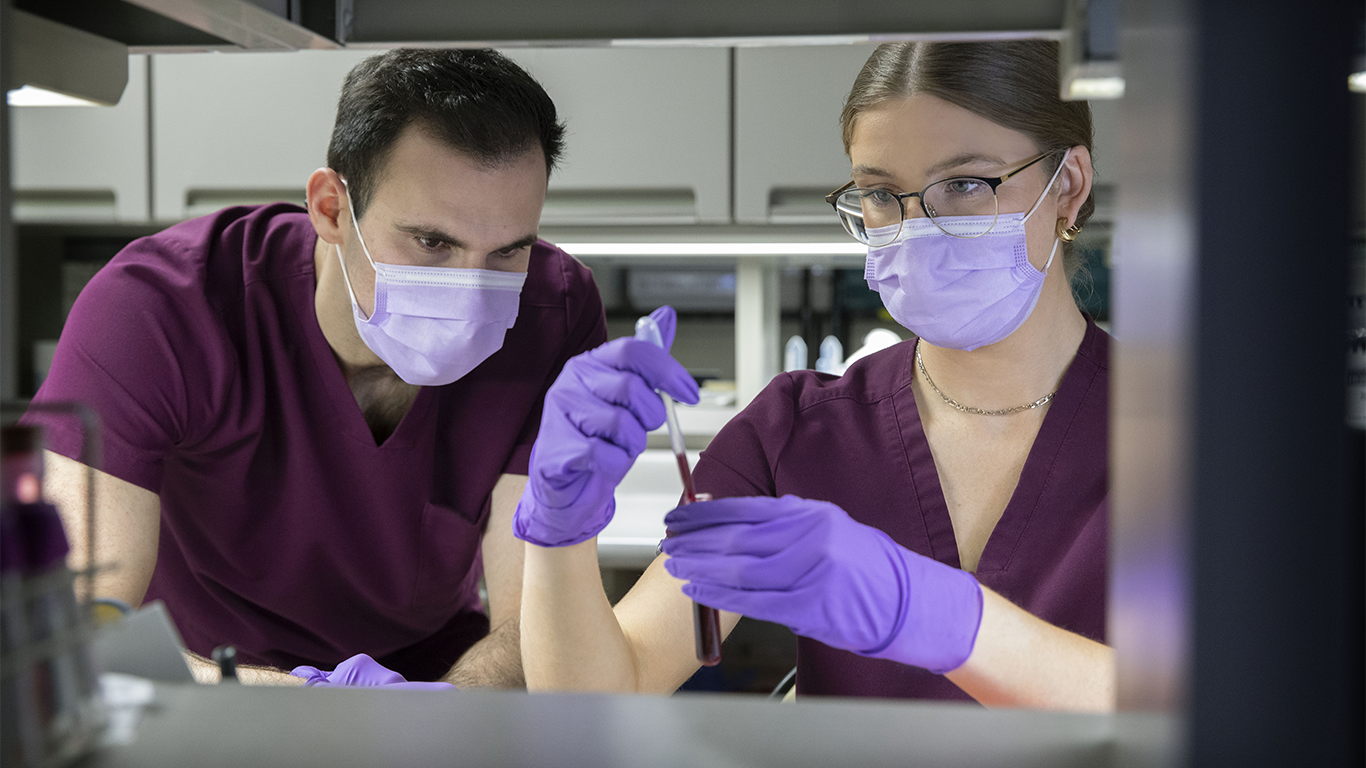Today, HonorHealth Research Institute celebrates its 20thanniversary.
So, what’s changed in 20 years?
Home to just two hospitals, HonorHealth was known in 2005 as Scottsdale Healthcare.
LOCAL NEWS: Here’s how HonorHealth is revolutionizing patient care
INDUSTRY INSIGHTS: Want more news like this? Get our free newsletter here
And if you were a Phoenix-area resident and had exhausted all current standard-of-care treatments for your cancer, your closest alternative was to travel to Tucson to access cutting-edge clinical trials.
“We had many patients driving down from Phoenix. Long days of therapy to get new investigational agents in Tucson,” said Daniel D. Von Hoff, M.D., a world-renowned cancer researcher who was then the director of the Arizona Cancer Center at the University of Arizona.
“At the end of the day, they’d have to drive back up. It was very difficult. Some of the treatments were daily. We decided that we needed to make sure that new therapies were more easily available for these patients,” added Dr. Von Hoff, who, among other positions and titles, is a former Chief Science Officer and an emeritus Virginia G. Piper Chair for Innovative Cancer Research at the HonorHealth Research Institute.
Scottsdale Healthcare was willing to help. Already operating since 2001 on the campus of Scottsdale Shea Medical Center, the Virginia G. Piper Cancer Center in 2005 became a launching pad for what originally was known as Scottsdale Clinical Research Institute at Scottsdale Healthcare.
Following the 2000 recruitment of Michael Gordon, M.D., FASCO, who since 2021 has been the Research Institute’s Chief Medical Officer, the Institute’s five research divisions began with Oncology studies. A year later, it added Cardiovascular and trauma research. Over time, the institute would add research divisions for Neuroscience, Bariatric/GI and Multispecialty (a platform for various up-and-coming disease research).
“This was about truly making an impact on the community where we could provide options and hope for patients and their families,” recalled HonorHealth CEO Todd LaPorte, citing an example of the changes over time: “The therapies available for pancreatic cancer patients today have advanced tremendously from where they were 20 years ago.”
Perhaps no one knows that better than Dr. Gordon, a pancreatic cancer survivor, who when he was diagnosed chose to be treated at the HonorHealth Research Institute, rather than any of the other premier hospitals or universities with which he has been affiliated over his career. Because of his own illness, Dr. Gordon has a heightened empathy for patients.
“There’s no way to come through such a journey and not have a sense of, and appreciation for, all the wonderful things in life, as well as an appreciation for the challenges we face,” said Dr. Gordon, who also serves as medical director of the Multispecialty Research Division. “Perhaps few are as challenging as a cancer diagnosis.”
After the creation a decade ago of HonorHealth — a merger of Scottsdale Healthcare and the John C. Lincoln Health Network — the research enterprise morphed into the HonorHealth Research Institute, as it is known today.
One constant over the past two decades is HonorHealth Research Institute’s pursuit of top-notch leadership, doctors, researchers and staff, and of state-of-the-art, innovative healthcare devices, drugs and techniques for patients, characterized by highly effective, leading-edge and safe clinical trials, sometimes the first in the world.

Institute gets its own CEO
A major inflection point came in 2007 with the appointment of Mark Slater, Ph.D., as CEO of the Research Institute and Vice President for Research at HonorHealth, providing a clear vision and philosophy to guide expansion into the future:
· An institute without walls, where collaboration is paramount.
· The best academic and scientific rigor matched to real-world community care.
· Nimble: fighting bureaucracy, eliminating obstacles, allowing innovation to proceed with urgency.
· Patient-centered strategic initiatives: leveraging the best science in pursuit of personalized medicine that addresses the unique circumstances of each patient.
· Commitment to compassionate care, treating every patient as we would want to be treated, combining the best science and care to give patients a fighting chance.
“My vision was — and remains — to create the kind of clinical research environment that I always wanted when I was a clinical scientist,” Dr. Slater said. “I always come back to one thing, gratitude: for HonorHealth, our dedicated physicians, scientists and staff; for our donors, our partners, and, most of all, for the courage of our patients and their families.”
Dr. Slater’s vision has helped guide the development of the Institute’s five research divisions and will help lead the way in the future as the Institute develops more research branches, such as the new expansion of laboratory science for the Center for Translational Science, and as the Institute establishes new partnerships, such as the recent affiliation with Arizona State University’s new John Shufeldt School of Medicine and Medical Engineering, both on the bioscience campus in downtown Phoenix.
From small beginnings, the Institute has evolved into a powerhouse of nationally and internationally recognized research innovation, with virtually unlimited potential, Dr. Slater said: “The best is yet to come.”
Oncology Research Division
Born to meet the needs of patients, the Oncology Research Division notched significant early wins:
In 2007, the Debi and Jerry Bisgrove Research Pavilion was dedicated on the Shea campus, providing some of the institute’s first laboratory space and clinical care facilities, and serving as a bridge between the research bench and bedside treatments. Debi Bisgrove was the subject of some of the Institute’s initial efforts to characterize, or profile, patient tumors by using the power of the human genome to unveil a patient’s unique genetic vulnerabilities to various cancers and identify potential drugs to treat each individual’s specific disease.
One such characterization led to the discovery of what is known as the hedgehog signaling pathway, so named because its molecular structure looks like the cartoon Sonic the Hedgehog. This pathway guides a chemical called vismodegib, which blocked abnormal cell growth in a number of human cancers, including basal-cell carcinoma, the most common skin cancer that, left untreated, can turn into a deadly malignancy. The Institute’s initial first-in-human research with the world’s first clinical trial patient (a local resident) showed that vismodegibcould clear up even late-stage basal-cell skin cancers that had spread to other parts of the body, including the liver, bone and lungs.
Follow-up collaborative, larger-scale global clinical trials led to FDA’s 2012 approval ofvismodegibas an oral pill for the treatment of basil-cell carcinoma — the first drug developed through HonorHealth Research Institute to receive FDA approval. Remarkably, this drug was approved in less than 5 years; a fraction of the time it takes most cancer drugs to be approved.
Another early victory was the creation of “The Triplet,” a combination of Abraxane, Gemcitabine and Cisplatin. Clinical trials would show a 71% response rate, meaning most advanced stage pancreatic cancer patients saw their tumors shrink, a finding that would lead to The Triplet becoming a new nationwide standard-of-care treatment for pancreatic cancer patients.
In addition to targeted therapies, the Institute is transforming cancer care through innovations in cellular therapies, which harness the power of the body’s own immune system. One such therapy is called TIL, short for Tumor Infiltrating Lymphocytes, immune cells embedded in cancer that are too weak to defeat the tumor. TIL-containing tumors are removed from the patient, then the TILs are isolated, enhanced and multiplied in a lab before being reintroduced back to the patient. The result is an army of billions of powerful immune cells to attack the cancer.
Cardiovascular Research Division
In 2006, on the heels of the Institute’s cancer research, the Cardiovascular Research Division was established, and with it came a raft of significant breakthroughs in treating cardiovascular disease affecting the arteries and other vascular structures with innovative stents, heart valves, and devices to help the heart keep a healthy rhythm. Using minimally invasive techniques to route therapeutic devices via catheters through large blood vessels, the division has invented new ways to avoid the trauma of open-heart surgery.
One example of the many innovations with new types of stents, the Research Institute in 2024 was one of the first in the nation and the first in the Southwest to treat a patient with a stroke-prevention stent that eliminates blockages in neck arteries that could potentially cause a deadly stroke by depriving the brain of oxygen.
The Institute helped pioneer trials that led to the 2019 FDA approval of the MitraClip, a now common method of repairing the mitral valve, which prevents blood from regurgitating, or backing up, into the left atrium and lungs from the left ventricle, the largest of the heart’s four chambers, which pumps oxygen-rich blood throughout the body.
Clinical trials at the Institute led to the 2025 FDA approval of the Tendyne Valve, an artificial replacement valve for the mitral valve.
In 2024, the Institute enrolled some of the nation’s first J-Valve patients into a clinical trial. This device prevents blood from regurgitating from the aorta, the main artery that feeds oxygenated blood to the body, into the left ventricle, a condition that if left untreated could lead to heart failure and death.
Through the years, the Institute has been at the forefront of helping develop relatively non-invasive implants that help the heart maintain a strong, steady beat. Where once they were large, some connected by wires from outside the body to inside the heart that had limited battery life. Today’s devices are small, wireless, and often reside completely inside the heart. Some devices can even be recharged from outside the body.
Neuroscience Research Division
Started In 2017, the Neuroscience Research Division, studies new treatments for diseases of the central nervous system and brain, including strokes and diseases of the immune system, and how they might affect other bodily systems such as muscles and the digestive tract.
The division quickly expanded to several HonorHealth hospital campuses, culminating in the 2021 opening of the Bob Bové Neuroscience Institute on the campus of Scottsdale Osborn Medical Center. The center is a beacon of hope for patients and their families facing some of the most challenging diseases of our time, including Guillain-Barré syndrome, a rapid-onset muscle weakness brought on by the immune system attacking the nerves. The division is also researching Parkinson’s disease, dementia, migraine headaches and concussions.
It also is part of a first-of-its-kind global effort begun in 2021 to prevent Amyotrophic Lateral Sclerosis (ALS), another debilitating and eventually fatal muscle-weaking auto-immune disease, also known as Lou Gehrig’s disease after the historically popular Major League Baseball player who died from this condition nearly a century ago. There still is no cure.
Bariatric/GI Research Division
The Bariatric/GI Research Division began in 2011, focused in part on helping patients achieve healthy weight, a growing challenge in a world where most American adults are overweight, and nearly 2 in 5 are considered obese.
The Institute is the first site in the nation to study genetic-based obesity. The division also studies digestive problems, such as GERD, blood-sugar abnormalities such as diabetes, and chronic inflammatory bowel diseases such as Crohn’s Disease. In 2022, the division helped secure FDA approval of the first and only interleukin-23 drug to treat moderate to severe Crohn’s Disease in adults.
Multispecialty Research Division
The Multispecialty Research Division began in 2022 as a place to organize research efforts that don’t fall into any of the Institute’s other four divisions.
While many of its functions began in 2019 — just in time for COVID pandemic studies into COVID-related pneumonia and high-risk adults — it since has also adopted studies surrounding an interventional pulmonary program (2022), a pulmonary hypertension program (2023), and a rheumatology program (2024). It also has included studies related to spine pain and breast cancer surgery.
Back to the future: The next 20 years
In building for the future, one of the most promising developments is the Institute’s new Center for Translational Science.
John Neil, M.D., HonorHealth’s Chief Physician Executive and Network Strategy Officer, said the new Center will further cement HonorHealth’s global reputation for delivering among the very best medical care: “We have served patients from all 50 states and more than 30 nations worldwide. Our new Center for Translational Science will build on our successes and exponentially increase the scientific rigor that is the backbone of our medical service.”
Power of Philanthropy
At key points along the Research Institute’s journey, significant multi-million-dollar philanthropic gifts from groups like Virginia G. Piper, the Starlight Foundation, Desert Mountain CARE and others provided funding for new research ideas and innovations that empowered the Institute to accelerate medical breakthroughs and improve patient outcomes.
Eyes on the horizon
“We will continue to work collaboratively, telling the stories of not only what we accomplish here but also what we achieve in partnership with ASU and others,” Dr. Slater said. “We will continue to deepen our science and make sure it is well integrated with our clinical research, instead of relying on the clinical research alone. We will focus on individualized solutions and early identification and early intervention of diseases, and ultimately on disease prevention, which could help people live longer and healthier.”
For more about HonorHealth Research Institute clinical trials: call 833-354-6667; or email clinicaltrials@HonorHealth.com.




